Friction Materials
Friction is defined as the resistance to relative motion that opposes the travel direction of an object. It is created by contact of one solid body with a divergent surface.
Friction materials are manufactured forms, used to harness friction in order to slow down or stop an object or machine.
Quick links to Friction Materials Information
The History of Friction Materials
Friction is a natural occurrence, and we have had a record number of people trying to either combat or use it since the time of the ancient Greeks. Greek and Roman scientists like Aristotle, Pliny the Elder and Vitruvius all studied the cause and mitigation of friction.
The classic laws of sliding friction were discovered by Leonardo da Vinci in 1493, but he did not publish the notebooks in which he wrote about them. They were rediscovered 206 years later by Guillaume Amontons, and became known as Amonton’s three laws of dry friction. Other scientists went on to elaborate on this, making important discoveries like the difference between static and kinetic friction. In 1734, John Theophilus Desaguliers uncovered the role of adhesion in friction, proposing that friction was the force necessary to tear adhering surfaces apart. In 1833, Arthur Jules Morin developed the concept of sliding versus rolling friction, and around 30 years later, Osborne Reynolds worked out the equation of viscous flow. These developments completed the classic empirical model of friction (static, kinetic and rolling) still used in engineering today.
Using knowledge like this, Bertha Benz invented brake linings and brake pads while driving across Germany in one of the first long-distance car trips ever taken (August 1888). The earliest manufactured brake linings were made from asbestos; this trend continued into the late 1900s, until 1989, when the National Institutes of Health (NIH) announced that asbestos exposure was dangerous to human health. (It can cause lung disease and cancer.) Since then, asbestos has been dropped from the friction material lineup, largely replaced by fibers like synthetic aramids.
Although it is an important aspect of many markets, the production of friction materials has recently become an industry in its own right. The friction material industry of today is competitive and thriving. Because of major changes in the industry throughout the years, such as the introduction of ceramics, many companies try to protect their own advancements and formulas, in order to beat out competitors. Friction materials continue to advance, and developments are a consistent occurrence in the industry market.
Friction Material Design
When making friction materials, manufacturers design for important product characteristics, such as: heat resistance, a high coefficient of friction, good energy absorption, durability, and resistance to wear and tear. To that end, they usually produce rough or textured surface materials, as smooth surfaces create little friction and are not efficient. They also design for application-specific requirements, such as torque capacity and speed of stopping. For example, applications that require quick stopping, must choose a material that creates a large amount of friction.
Another thing they think about is the type of frictional force they are looking to create, as the type of material suited to a given task is dependent upon the type of friction. There are three main types of frictional force: static, kinetic and rolling.
- Static Friction
- Found between two solid objects that are not moving relative to each other, preventing movement entirely. Slope is an important consideration when utilizing this particular type of friction.
- Kinetic Friction
- Also known as dynamic friction, occurs between two objects moving relative to each other. Both surfaces may be moving or one may be sliding along a stationary object.
- Rolling Friction
- Involves wheels or balls. The rough texture of friction materials catches the wheel and stops it from sliding or slipping. A car tire spinning on ice or snow, for instance, is an example of low rolling friction and thus the tire does not catch on the ground, but keeps moving around.
Materials Used for Friction Materials
The raw materials available for friction material production range from organic to ceramic to fibers and metallic materials. Ceramic materials are used in heavy loads and high temperature applications. Ceramic can withstand thermal energy higher than any other alternative, however, it wears pretty fast. Organic friction material makes use of fiberglass and other materials, since asbestos proves to be a hazardous material for humans. Aramide fibers such as Kevlar are also used for making friction materials, it has the property of organic material that helps in smooth engagement of components and braking ability of ceramic pads. The other options involve high-end metallic materials, such as sintered steel and phosphate steel. No other additives are required for making metallic pads; however, they take a heavy toll on the machinery, therefore, used only in performance vehicles. Finally, semi-metallic brake elements are also available using copper, brass and steel wool bonded by resin as these compounds share many of the long-lasting characteristics of ceramic options.
Friction Material Images, Diagrams and Visual Concepts
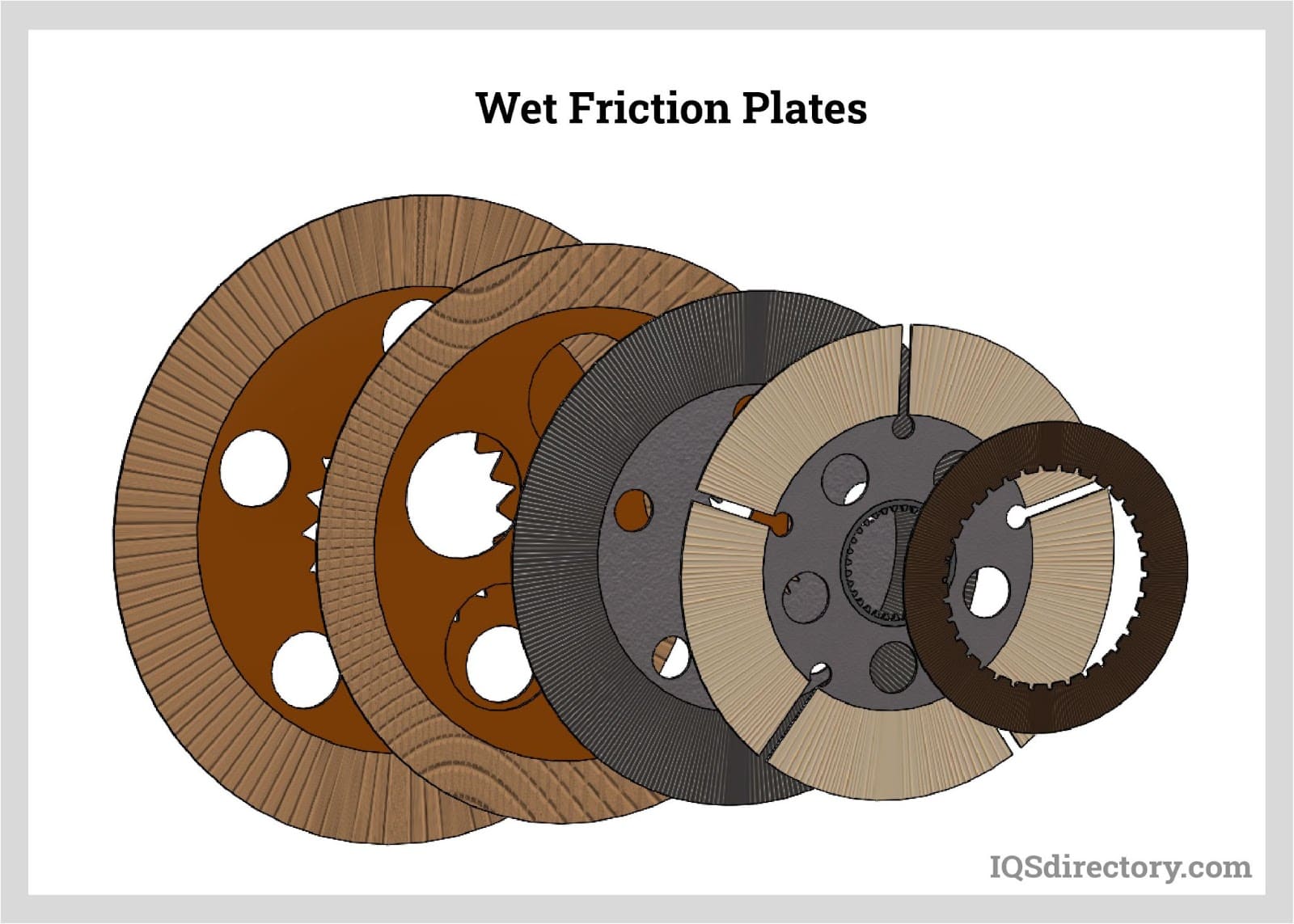 Friction materials, substances that produce friction between solid surfaces in order to control or stop forward or backward motion.
Friction materials, substances that produce friction between solid surfaces in order to control or stop forward or backward motion.
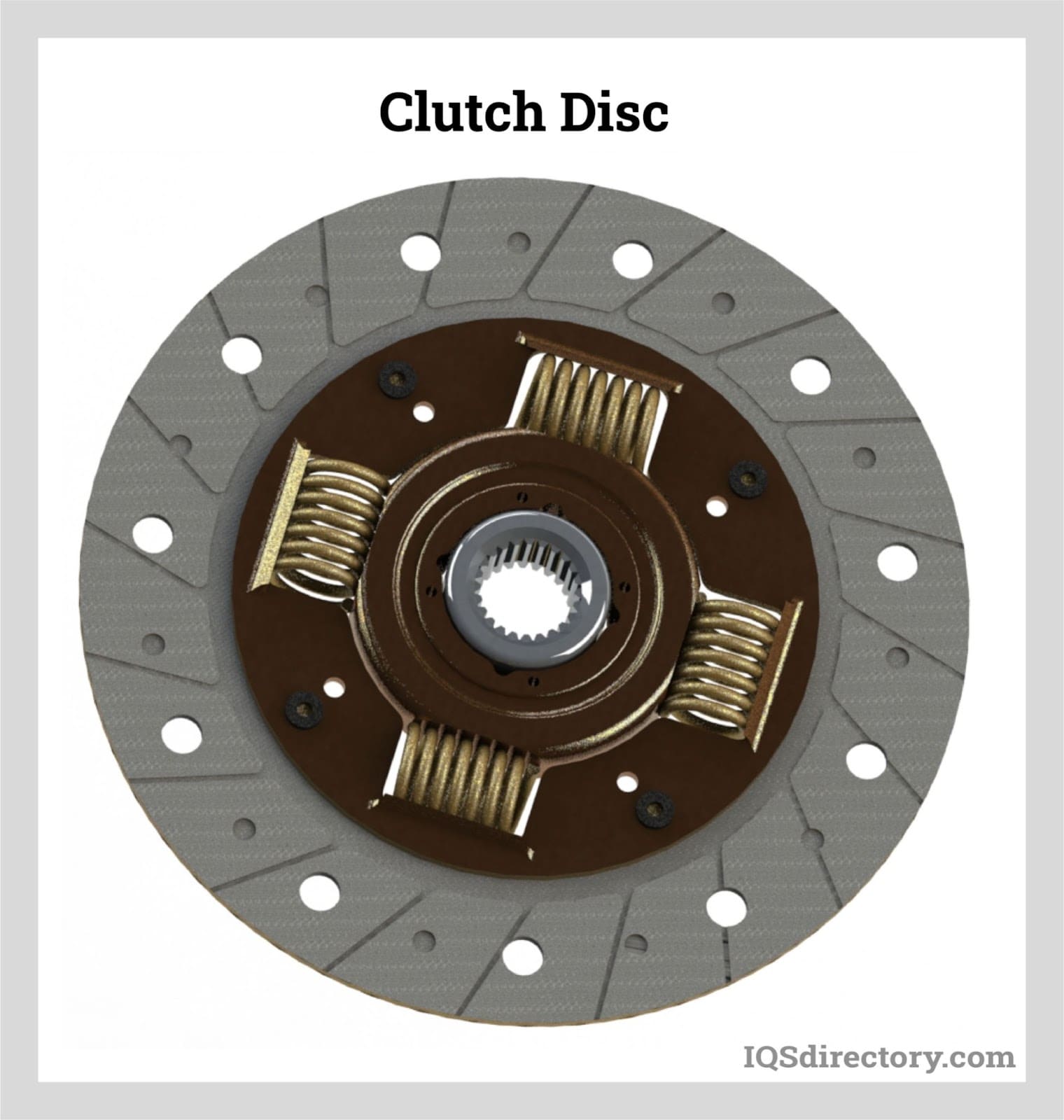 The clutch discs, or linings is attached to the shaft of the transmission and engages the engines when the clutch is released, when the clutch is disengaged, the transmission is disengaged and allows for the changing of gears.
The clutch discs, or linings is attached to the shaft of the transmission and engages the engines when the clutch is released, when the clutch is disengaged, the transmission is disengaged and allows for the changing of gears.
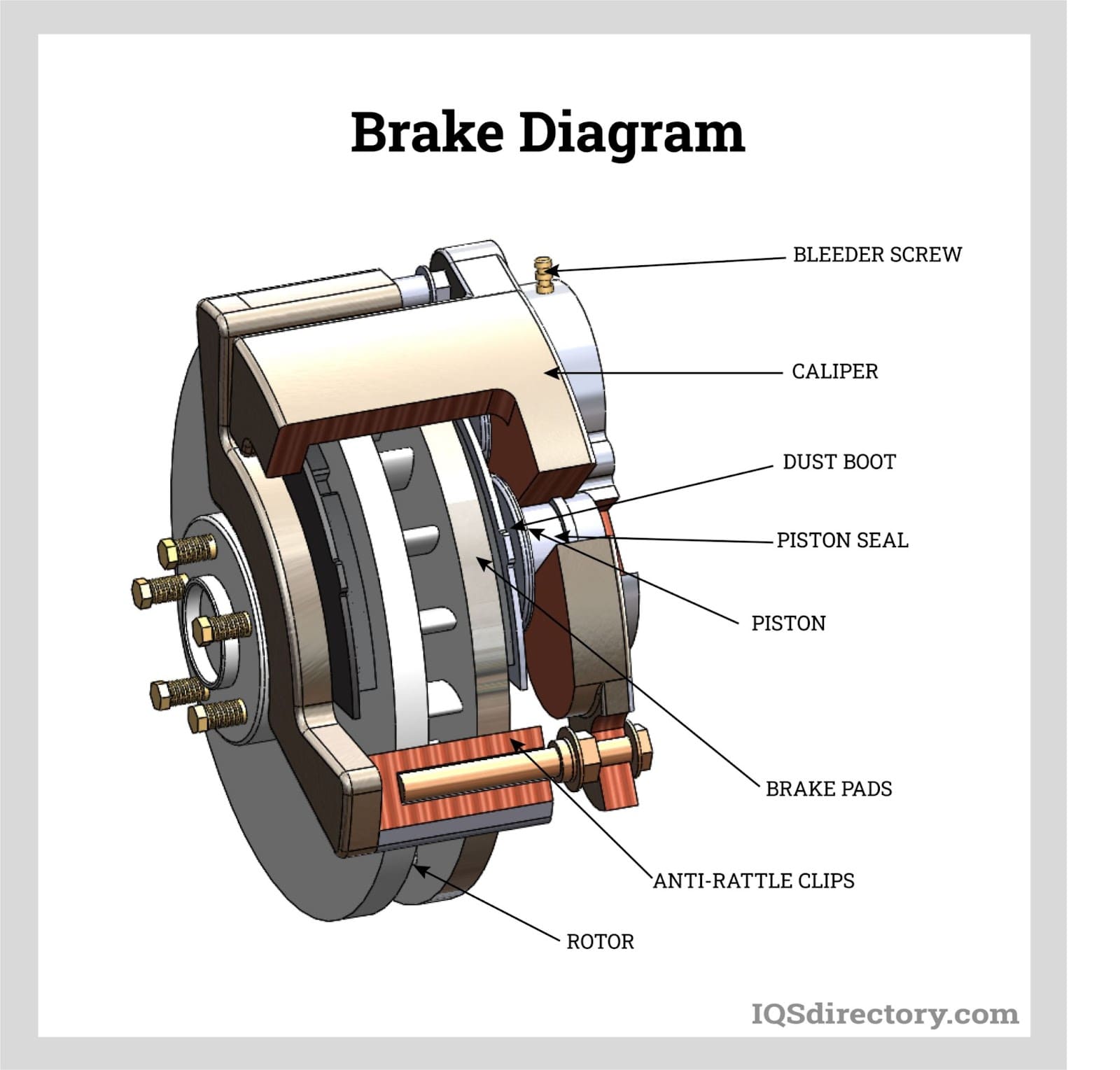 Diagram of disc brakes mainly used in vehicles.
Diagram of disc brakes mainly used in vehicles.
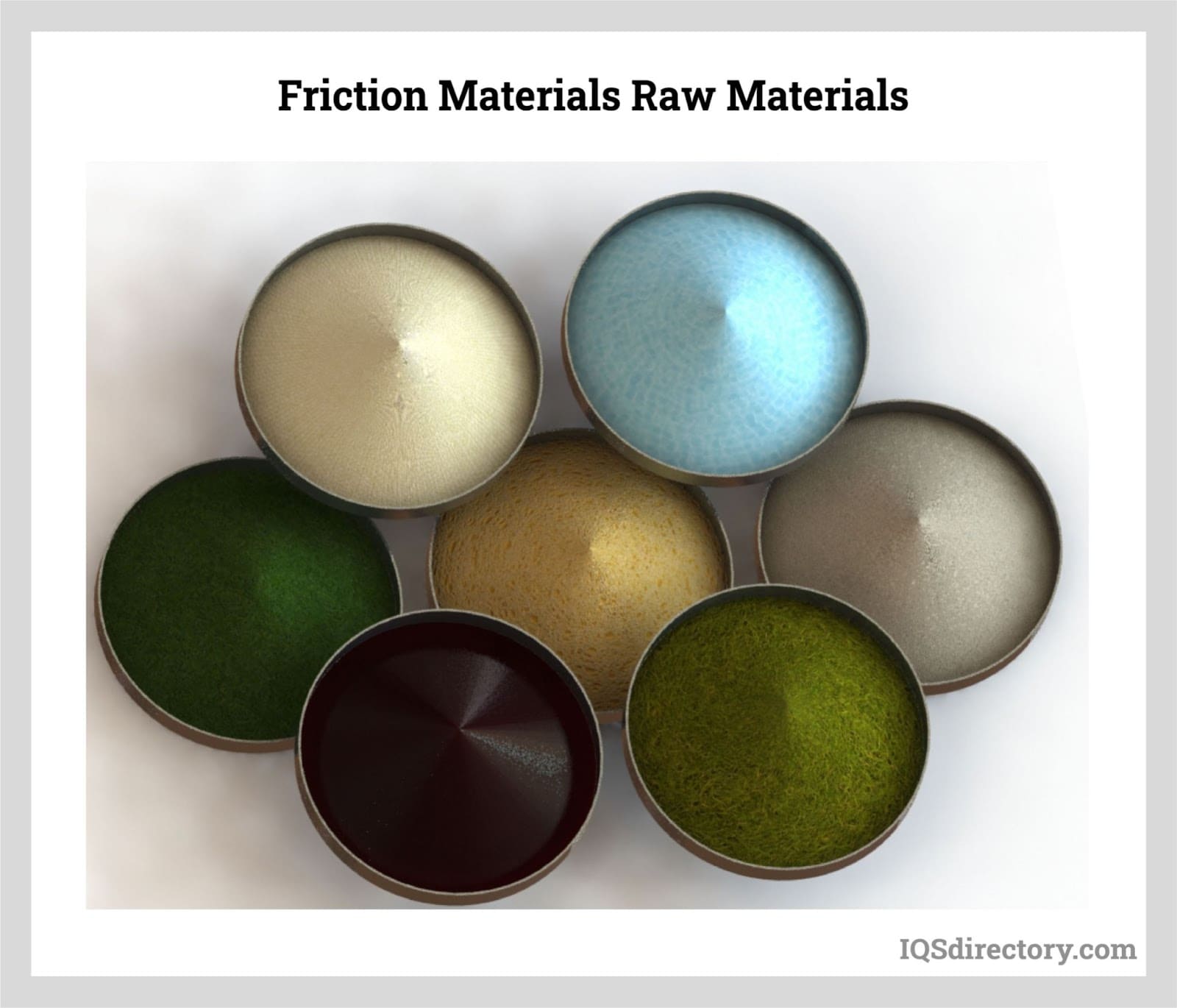 The three types of friction materials are organic, metallic, and inorganic.
The three types of friction materials are organic, metallic, and inorganic.
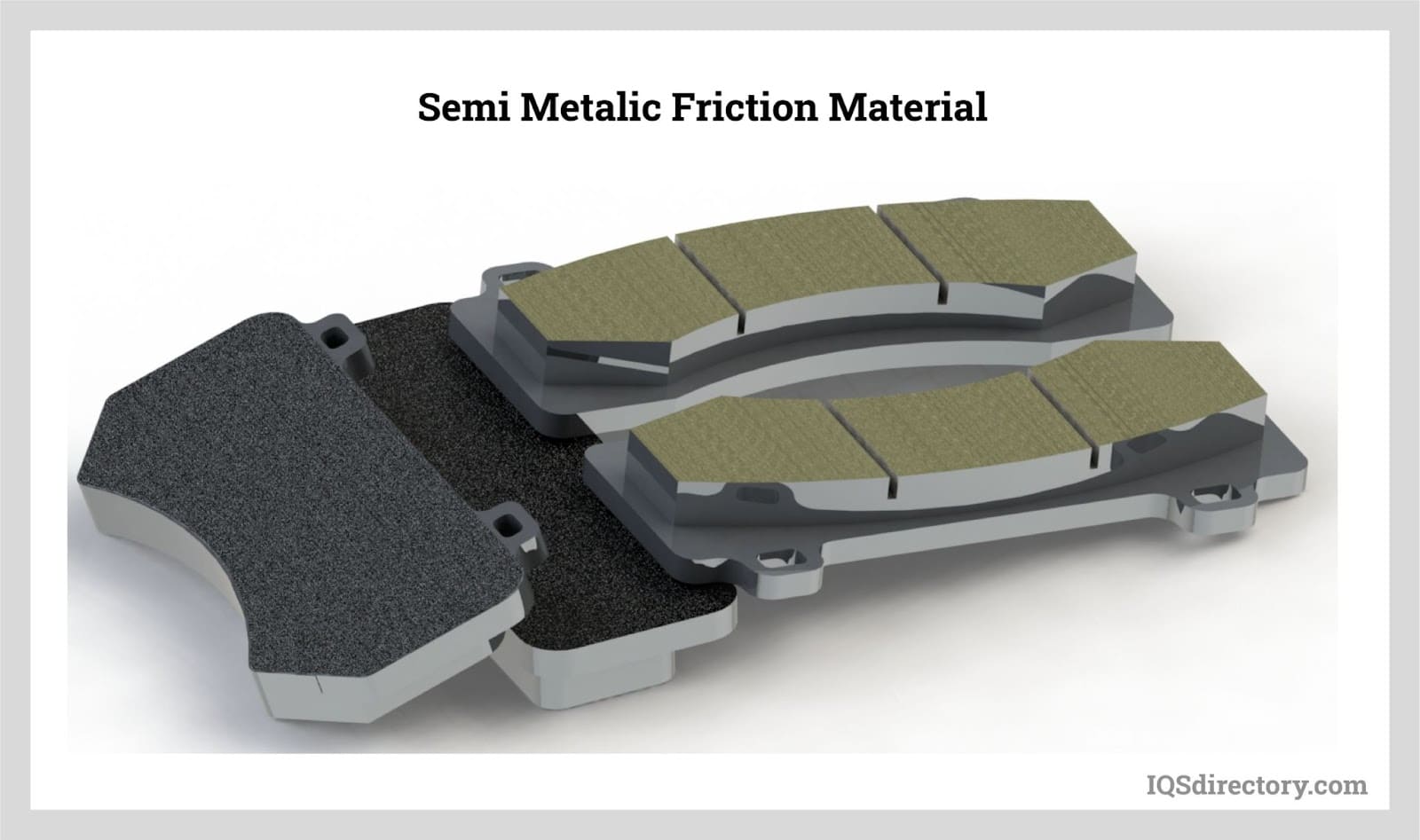 Semi-metallic friction materials are made of sintered metals and synthetic fibers, which are the longest lasting type of friction material.
Semi-metallic friction materials are made of sintered metals and synthetic fibers, which are the longest lasting type of friction material.
Friction Material Types
- Friction Disc
- Or a friction plate, is a plate bonded with friction material, used in automotive braking systems. Friction plates are usually constructed of durable metal, and because they can be noisy, manufacturers often coat them with rubber and other high friction materials.
- Clutch Disc
- A type of friction disc, used to connect a vehicle engine to the input shaft of the transmission. This connection allows for the temporary separation required to shift gears.
- Clutch Facing
- Used to maintain systems with a lower coefficient of friction. The lower coefficient facilitates smooth and stable clutch engagement and disengagement. It also creates a quieter system.
- Brake Pad
- Also known as brake bands, are friction mechanisms of brakes. They slow down the system when they are pressed against the friction disc. Like friction discs, they consist of a friction surface bonded to a metal plate. There are many types of brake pad, including disc brake pad and ceramic brake pad varieties.
- Brake Lining
- Another component of brakes. This friction material is heat resistant, which is important in friction systems, since they create so much heat. Brake lining is used on many brake varieties, including the drum brake and the disc brake.
- Friction Shoe/Brake Shoe
- Along with friction pads, are the most well-known forms of friction materials used in braking mechanisms. In disc braking systems, they are placed in brake calipers and touch the disc to convert kinetic energy into the thermal energy that slows the automobile.
- Friction Clutch Set
- All clutches are fitted with friction materials for smooth transmission action in machines.
- Friction Column
- Or blocks, have specialized movement regulation applications in the mining and oil rigging industry. To use them, manufacturers attach them to crane components, such as winches and hoists. regulate the movement.
Applications for Friction Materials
Friction materials are essential to the safe and controlled usage of all types of machinery. They induce resistance and decreased speed or movement in a number of different systems, such as industrial machinery, automotive brake systems, industrial brake systems, and operating systems. They also transfer power.
Because of their important functions, the friction material market is quite robust, and there are several applications for which friction materials are essential. Some of the products that rely on friction materials to function are: brake pads, clutch sets, brake bands, brake lining, clutch facings, disc brake pads, clutch discs and friction discs, brake shoes and brake block.
These materials are utilized by a variety of industries such as automotive manufacturing, general manufacturing, aircraft, aerospace, railroad, mining, defense, oil and gas, forestry and construction.
Features of Friction Materials
Depending on your market, your friction materials may work a little differently.
Brakes, for example, use friction materials to slow and stop wheels and other mechanisms from moving. When you press the brake, it activates a system that places friction material against the moving disc, which slows down the connected tire.
A traditional braking system prevents motion by means of friction, converting kinetic energy of the vehicle or a moving object to heat. However, in regenerative braking, which is relatively a new concept, the kinetic energy is converted into electrical energy. This is found in hybrid or electric vehicles.
Standards and Specifications for Friction Materials
We recommend that you purchase RoHS compliant friction materials. RoHS (Restriction of Hazardous Substances) is an EU directive that restricts the use of certain hazardous materials. While RoHS compliance is not required in the United States, if you work with products to be shipped overseas, you need this certification. Also, it’s just a good guide to follow. In the United States, make sure that your friction materials comply with standard regulations put out by the EPA. Also talk to your manufacturer about SAE International and FMSI (Friction Materials Standards Institute).
Things to Consider When Purchasing Friction Materials
- Material Considerations
- Since there are a number of options in friction material, it is necessary to consider factors that determine its functionality and life. Before buying a friction material, you need to find out:
- Whether the material provides smooth engagement.
- Whether the material can resist brake fade as the temperature rises.
- Whether the material endures temporary exposure to water.
- If your supplier can answer "yes" to all of these questions, then you can go ahead feeling confident that this friction material will serve you for longer periods.
- Manufacturer Considerations
- Speaking of suppliers, the key to finding the friction material you need is working with the right manufacturer. Find this manufacturer by scrolling up to the top of this page and checking out the proven friction material companies we’ve listed for you. Visit their individual websites and browse their products and services. Pick three or four that you believe could serve you best, and then reach out to each of them with your specifications and questions. Compare and contrast not only their answers, but their attitudes. Look for a friction material manufacturer who will provide you not with a barebones product, but the best product possible, no matter your budget.
Proper Care for Friction Materials
Friction materials are heavily used products, so it is not easy to care for them, so watch out for signs of wear or damage.
Due to the nature of their work, your friction materials, regardless of wear resistance, will become worn at some point. When this happens, you need to replace them. If you don’t, in the case of automobiles, the backing or rivets will rub up against the rotors or drums during braking, and eventually cause extensive damage. You will likely have to re-machine or replace the damaged parts. Avoid this by looking out for the classic warning sign of brake wear, squealing. If you wait too long, your next warning sign (suggesting damage) will be an unpleasant grinding sound or sensation.
Another peril for brake friction material is contamination by leaked brake fluid or oil. If you hear brake chatter, like brake pads are vibrating as you use them, they’re probably contaminated. Fix this by finding and repairing the leak source and replacing the brake pad. Note: you must always replace both of your brake pads at the same time. This is because unmatched lining thicknesses or materials will cause uneven braking, which can be both dangerous and inefficient. Fortunately, friction materials like these are easy and inexpensive to replace.
Friction Materials Terms
- Balance
- Refers to the stability between the front and rear brakes.
- Bleeding
- The process by which overheated or spoiled brake fluid and air bubbles are removed from the brake system.
- Brake Drum
- Metal housing bolted to an axle and vehicle wheel that looks like a large jar lid. Brake shoes are forced against the drum to stop rotating wheels.
- Brake Lining
- Heat-resistant friction material that presses against the disc/drum to create braking force.
- Brake Pad
- Made of friction materials and bonded to metal plates. Brake pads need to be replaced occasionally due to heavy wear.
- Brake Materials
- Brake materials encompass a wide variety of durable and heat resistant substances used in the construction of devices which reduce the speed and stop spinning surfaces of vehicle wheels as a result of increased friction. Braking systems that utilize these materials are made up of several components such as brake bands, brake lining, brake pads, brake shoes and brake blocks.
- Burnish
- Process of wearing in brakes so that the contact between the friction material and the rotor or drum becomes stable.
- Caliper
- The assembly that houses the brake pad(s) and applies them to the rotor. This also houses the hydraulically operated pistons to which the pads are bonded.
- Clutch
- Any of various contraptions used to engage and disengage two moving parts of a shaft or shaft and driving mechanism. When changing gears, the clutch pedal is pressed, disengaging the clutch and allowing the gear change; when released, the clutch engages and transfers the rotating motion throughout the entire driveshaft.
- Clutch Materials
- Clutch materials encompass a wide variety of durable and heat resistant substances used in the construction of devices used to connect the engine of a vehicle to the transmission input shaft allowing the temporary separation needed to shift gears and coast. Clutch systems that utilize these materials are made up of several components such as clutch facing, pressure plates, clutch discs, and flywheels.
- Coefficient of Friction
- The ratio of force necessary to move an object compared to the weight of the object itself.
- Disc Brake
- Consists of brake pads, caliper and rotor. This is the part of the brake system that actually stops the vehicle.
- Drum
- A large circular metal housing that looks like an oversized jar lid and is bolted to a vehicle's axle and wheel. Brake shoes are forced against the inner section of the drum, which then stops the rotating wheel.
- Dynamometer
- Apparatus in a laboratory used to test brake system performance.
- Fade
- Temporary reduced braking power. Fade results from overheating of the friction material.
- Groove Patterns
- Grooves on friction material that help dispel heat, get rid of fluid and eliminate noise.
- Master Cylinder
- The cylinder that contains hydraulic fluid and a piston. It is connected directly to the brake pedal and transmits pressure to the brake operating system.
- Recovery
- The return of braking performance to a normal level after fade has diminished. This measures friction materials' ability to perform after overheating.
- Rotor
- Also referred to as a disc or drum, this is the circular metal object to which the brake pads are applied, creating friction to slow and stop the vehicle.
- Shoe
- A steel semicircular form coated with a friction agent that presses against the inside of a drum when activated.
- Squeal
- High-pitched noise made when braking. Squeal indicates that brakes should be inspected for wear.